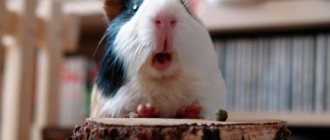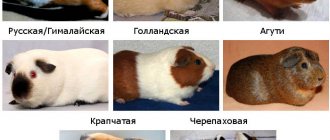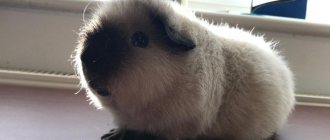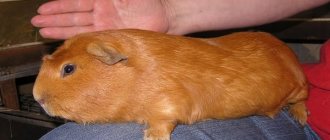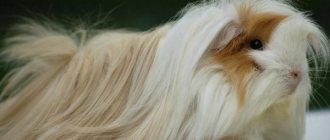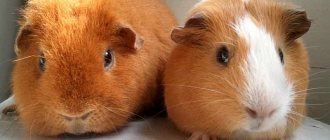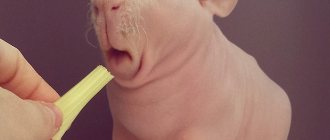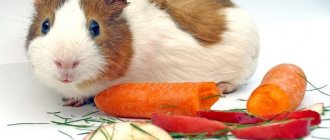In some ways, guinea pigs are unique animals. And it’s not just about their intelligence and ability to recognize their owner. They can boast of a special skeletal structure. Therefore, before buying a pet rodent, you need to learn about the structure of its body, the characteristics of life in the wild, its dietary preferences and care rules.
This information will help the future owner not to make mistakes that could adversely affect the health of the animal.
Description of the animal
The homeland of the guinea pig is South America. Those who lived there in the 5th millennium BC. e. Indian tribes were engaged in breeding these cute rodents. They domesticated animals to eat their meat. Animals were also sacrificed to the gods. After Columbus discovered America, animals came to the European continent.
The guinea pig does not live in water and does not like to swim, although if necessary it can swim across a small stream. It received this name because it was brought by ship by sea, and in appearance it somewhat resembles a pig.
Currently, residents of South America also use guinea pigs as a source of dietary meat. It is similar in taste and nutritional value to chicken.
Guinea pigs are rodents that belong to the pig family. In their natural environment, animals are found in mountainous areas, forests and dense forest edges. They form groups of 10-14 individuals and settle where there is a lot of plant food.
The life of guinea pigs in the wild is full of surprises - they constantly have to fight for survival, so the animals are distinguished by their agility and endurance. They easily climb rocky slopes and tree trunks when fleeing from enemy pursuit.
Wild guinea pigs are slightly smaller than their domesticated cousins. Rodents have a strong skeleton and well-developed muscles. Their fur is colored brown. Thanks to this color, it is easier for them to hide among the stones.
Unlike most representatives of the rodent order, wild guinea pigs do not live in burrows. They use rock crevices and tree hollows as homes. To furnish their “home,” rodents use available materials—dry grass, branches, and fluff.
During the daytime, the guinea pig hides in a shelter, and at dusk comes out in search of food. Pets can be active at any time of the day.
Appearance
Those who carefully studied the description of the guinea pig noticed how unique the structure of its body is. It does not look like rabbits or chinchillas, and even more so has significant external differences from rats and hamsters.
What does a guinea pig look like:
- the body is cylindrical, well-built, with well-developed muscle mass;
- the head is quite large;
- wide blunt muzzle;
- eyes are round in shape, reminiscent of beads;
- ears are medium-sized, drooping, with wavy tips;
- the neck is so short that it is practically invisible;
- limbs of short length;
- there are 4 toes on the front paws, 3 on the hind paws;
- the tail is missing.
The coat can vary in length, texture and color depending on the breed of guinea pig. The cover can be long or short. There are also hairless varieties.
Breeders managed to breed rodents with smooth, hard and even curly hair.
Dimensions and weight of the rodent
The guinea pig grows to a size of about 24-35 cm in length. The height at the withers is 5-7 cm. The dimensions of the animal largely depend on the breed and gender - females are slightly smaller than males.
A guinea pig weighs 700-1500 g. The size of an adult male varies between 22-35 cm, and body weight - 1-1.8 kg. Animals develop most actively until they are one year old, but continue to grow for several more months.
A guinea pig reaches its maximum size when it is 1.5 years old. Then its growth stops.
Characteristics and structure of a guinea pig
Anyone who sets out to learn everything about guinea pigs should also get acquainted with the structural features of their internal organs:
- Oral cavity. The incisors of these animals grow throughout their lives. There are no fangs, and the lower jaw can move in different directions. To grind down teeth, solid food is introduced into the pet's diet.
- Limbs. Guinea pigs' paws resemble miniature hooves. The claws on the fingers grow quickly. Therefore, they need to be trimmed in a timely manner. Neglecting this recommendation leads to deformation and curling of the claws.
- Digestive system. In guinea pigs, the total length of the intestines exceeds the length of the body by 2.5-3 times. The process of digesting food takes 5 or more days. Prolonged fasting is dangerous for the life of a rodent, since food moves further through the intestines only after the arrival of a new portion.
- The cardiovascular system. The heart of a guinea pig weighs 2-2.5 g. The tiny “motor” makes 350 beats per minute.
- Mammary gland. Few people know that the female has only one pair of nipples.
- Fecal pocket. Male guinea pigs have a small fold-like formation in the anal area. It contains glands that produce a secretion with a pungent odor. With its help, males attract females.
Character and habits
Decorative guinea pigs are friendly animals without a hint of aggression. They quickly get used to their owner and become tamed. The rodent likes to be picked up and stroked.
Many pets eagerly await their owners' return from work - they rise on their hind legs and peek out. At the same time, pigs make a variety of sounds. They resemble water gurgling, chirping and purring. When an animal is afraid, it squeaks shrilly.
Guinea pigs are very clean. In nature, this trait helps them remain unnoticed by the enemy. They love to clean and lick themselves and willingly help their neighbors with this.
Guinea pigs are quite smart animals. They remember the owner's voice and respond to it. Some rodents respond to their name.
Health and life expectancy
In its natural environment, a guinea pig can live 1-4 years. There, the animal can become prey for wild animals and large birds every day. In addition, there is a chance of contracting a contagious disease and dying.
At home, a rodent can live twice as long - about 8 years. Some individuals manage to cross the ten-year threshold. The long-living record holder delighted his owners for almost 15 years.
The most common rodent diseases:
- Dental problems. Due to the lack of solid food, the incisors do not have time to grind down and become too long. This leads to damage to the soft tissues of the oral cavity, drooling and other troubles.
- Injuries. The greatest danger comes from falling even from a small height. A pig can break its spine or leg.
- Avitaminosis. Guinea pigs do not produce vitamin C; they must get it from their food. With its deficiency, the animal’s immunity weakens, bald spots appear on the body, and the gums begin to bleed.
- Colds, bronchitis, pneumonia due to hypothermia. The first sign of illness is a runny nose. If left untreated, the cold will turn into bronchitis, and then into pneumonia.
- Conjunctivitis. This is an inflammation of the mucous membrane of the eye, in which there is redness of the eyelids, tearing and purulent discharge. The main causes of the disease are viral or bacterial infection and allergies.
- Diarrhea. If your guinea pig develops diarrhea, you should see a doctor immediately. Loose stools can be one of the symptoms of a deadly infectious disease.
- Tumors. Benign and malignant neoplasms are common in rodents. They affect the lungs, lymph nodes, mammary glands and skin.
Important! The animal will live a long time if you carefully monitor its condition every day. Any alarming symptoms, such as lethargy, loss of appetite, snot, wheezing, should be a reason to visit the veterinarian.
What are the main health threats?
Predators of course. If you do not let your pet go for a walk in the forest, then the main threat is reduced to zero. But besides this, the animal may have other health problems, and the main one is parasites. To avoid them, we recommend deworming once every 3 months.
In addition to worms, the animal may be bothered by colds, intestinal problems and obesity.
How to identify health problems:
- lies with eyes closed
- rapid or difficult breathing
- cough
- increased thirst
- tousled, matted fur
- hair falls out when touched lightly
- nasal discharge, runny nose
- festering eyelids and eyes
- formation of ulcers on the skin
- trembles finely
- frequent dry or loose stools
- convulsions and paralysis
- presence of small bloodsuckers
Is it worth keeping a guinea pig at home?
Guinea pigs have a much larger following than rats or hamsters. They are valued for their pretty appearance and many other advantages.
However, pigs also have disadvantages.
| pros | Minuses |
| Low cost. Prices for rodents are an order of magnitude lower than for purebred puppies, kittens or chinchillas. | Noise. Guinea pigs have many different sounds in their arsenal. They squeak, chirp, grunt, and at night they constantly rustle with the litter. This irritates some people. |
| Friendly disposition. Guinea pigs love affection and enjoy communicating with people; they are not prone to aggression. | Animals do not tolerate loneliness well. And so that they don’t get bored, you’ll have to get a few pigs. |
| Animals know how to get along with each other. | Guinea pigs can cause allergies. |
| Cleanliness - pigs constantly take care of their coats and therefore practically do not smell. | Problems with veterinary care. Not every city has a rodentologist (a doctor who specializes in treating rodents). There is a possibility that the pig will get sick and the veterinarian will not be able to help her. |
| Easy to care for. Pigs do not take up much space, do not damage furniture, and do not need to be walked outside. You just need to keep the cage clean, comb out the fur and trim the claws. | Guinea pigs have low intelligence, so training them to perform tricks is quite difficult. |
| Long life expectancy. | These animals eat their own feces. Some people find this behavior off-putting. |
| Many breeds and colors. Each person can choose a pig to their taste. | |
| Unlike hamsters, these animals are awake most of the day, allowing loving owners to spend a lot of time with them. |
You can't make a rash decision. This is a living creature that will have to be given attention and money spent on its maintenance.
Families with children
The guinea pig gets along well with small children. If you don’t openly torture her, then the pig will be happy to let small children play with her.
Guinea pig and girl baby
Love the animal, take care of it, and it will respond in kind, and everyone will be happy, as in the photo above. This is a kind, peace-loving animal.
And remember - we are responsible for those we have tamed!
How to choose a guinea pig
It is better to purchase a guinea pig from a breeder with a good reputation. People who professionally breed rodents value their name and will not deceive customers.
First of all, you need to decide on the choice of breed. There are short-haired, long-haired and hairless guinea pigs.
- The first group includes breeds - satin, crested, rosette, teddy, crested, self, Dutch and others.
- Longhaired - Sheltie, Peruvian, Angora, Merino, Texel, Alpaca, Cornet.
- Hairless - Baldwin and Skinny.
A guinea pig costs about 2,000 rubles. Rare breeds and animals with unusual colors will cost more – up to 3,500 rubles.
To choose the right pet, you should look not only at appearance. The main thing is to buy a healthy animal. In what cases should you refuse a purchase:
- if your guinea pig has a runny nose;
- red, swollen, watery eyes;
- the animal is lethargic;
- the coat looks unkempt and disheveled;
- wet or dirty under the tail;
- the guinea pig is breathing heavily, wheezing, sneezing;
- there are scratches or bald spots on the body.
Such symptoms should alert the buyer. They indicate the animal’s poor health.
Care and maintenance
Guinea pigs will need a comfortable and safe home, equipment and quality food.
Attention! When your pig arrives home, for the first couple of days she will look for a place to hide. It is better to give the animal time to adapt and not touch it.
Cage and filler
The animal can be kept in a cage, terrarium or enclosure. The main requirements for a guinea pig's home:
- availability of free space;
- design safety;
- good ventilation;
- ease of cleaning.
An aquarium or closed plastic cage is not a suitable option. There is poor air circulation in them. Some stores sell guinea pig racks. These are multi-tiered open-type structures with plastic pallets. They are somewhat reminiscent of a shop window. The floors are connected to each other by steps or gentle stairs with notches.
Such a dwelling does not take up much space in the apartment and is well ventilated. In addition, rodents living in these structures are constantly in sight of the owners, making it easy to observe them. The rack is easy to clean since the top is open.
Attention! It is important to choose the appropriate size cage or enclosure. This takes into account the number of adult rodents that will live there. At least 0.7 m2 should be allocated per individual.
A house for a guinea pig is placed in the cage. Each rodent should have its own shelter. It is quite large - approximately 35 cm in length, 20 cm in width and 7-10 cm in height. An adult animal must fit freely inside.
In addition, you will need a hay barn, 2 feeders and a drinking bowl. It is worth giving preference to the nipple one, since pets will not be able to knock it over, which means they will not be left without water.
Filler is used as bedding. Its function is to absorb moisture and eliminate unpleasant odors. For rodents, hardwood shavings or compressed sawdust are suitable.
Experts do not recommend installing a running wheel, as guinea pigs have a weak spine.
Hygiene
Caring for a common guinea pig includes cleaning the cage, brushing the fur, and trimming the nails. Inexperienced owners believe that rodents need to be bathed when they smell unpleasant. In fact, the animal washes its coat on its own. If an unpleasant odor appears, it means you need to change the filler in the cage more often. Guinea pigs are bathed in exceptional cases when it is impossible to remove dirt on the fur by other means.
The animal's home is cleaned every 4-7 days. The more pets live there, the faster the litter gets dirty. The dirty filler is thrown away and the tray is washed with hot water. Cleaning products must not be used.
It is necessary to periodically examine the animal's ears. If a lot of sulfur has accumulated in them, it is carefully removed with a cotton swab or disk. Claws are shortened once a month. Only the very tip is cut off with a special nail cutter.
It is imperative to monitor the condition of the fecal pouch in males. Sometimes shavings and other debris get into it, and droppings also accumulate. All this can lead to skin irritation and cause inflammation.
Taming
When the animal gets used to its new place of residence, you can begin to accustom it to your hands. The main thing in this matter is patience, there is no need to rush. First, the pig must get used to the owner's voice.
You need to approach the cage several times a day and talk affectionately to your pet. It is advisable to call him by name. Communication with a person should be associated with something pleasant, so you should treat the rodent with a piece of apple or carrot every time.
Then you can move on to the next stage - hand feeding. When the guinea pig stops being afraid, he will come closer and take the treat right from the palm. It is important not to make sudden movements so as not to scare her. Gradually, the animal will get used to the smell of the owner’s hands, and then it can be taken on your lap.
Features of feeding
It is known that guinea pigs are domesticated rodents that feed on dry grass. The basis of their diet is hay. In addition, animals eat grain feed:
- oats;
- corn;
- barley;
- wheat;
- sunflower seeds.
It is beneficial for animals to eat vegetables and fruits, as well as fresh herbs. These are valuable sources of vitamins and microelements. In winter, rodents are given grass pellets or grain sprouts. The diet must include branches of fruit trees.
Guinea pigs should not be offered food of animal origin, as well as potatoes, red beets, and citrus fruits. Confectionery and bakery products are strictly prohibited.
Age
You should know at what age it is better to buy a guinea pig: 5-10 weeks. Up to three weeks of age, the cubs feed on their mother's milk. It makes up the bulk of their diet and strengthens the immune system. The older an individual is, the longer it takes to adapt to a new home.
It is possible to determine the exact age of the animal only before it reaches one year of age. During this period, the animal continuously grows and gains weight. The body length at 5 weeks is about 19 cm. The average length of an adult is 25–30 cm, weight is 1 kg. In addition, the teeth of young animals are white and even (in the absence of dental problems). After reaching 1 year, the appearance of the animal practically does not change. All you have to do is take the seller’s word for it or find out the age from the veterinarian.
If you want to have a female guinea pig, you should be especially careful. Animals reach sexual maturity by two months, and cases of acquiring pregnant females are not uncommon.
Breeding
Puberty in guinea pigs occurs at 8 weeks, but the first mating should be delayed. At this age, the female is still too young to become a mother. Reproduction can begin when she is 5-6 months old.
Estrus in a guinea pig occurs every 13-20 days and lasts up to 48 hours. The most favorable time for fertilization of a female is the first 5 hours of estrus. Its beginning is indicated by the behavior of the female - she arches her back and raises her butt. Mating takes place on neutral territory or in the male's cage.
The absence of another estrus indicates that pregnancy has occurred. A guinea pig bears its young for 64-72 days. The period depends on the number of embryos and breed. There are from 2 to 5 cubs in a litter.
Little piglets are born with fur, they see, hear, and already on the second day they can eat chopped vegetables, since they have teeth. However, mother's milk is vital for them - it contains antibodies that protect babies from dangerous diseases. The cubs are separated from their mother at the age of 3 weeks and sorted by gender.
A guinea pig is an ideal pet for those who for some reason cannot have a dog or cat and do not like rats and hamsters. This animal is capable of filling the lives of its owners with pleasant emotions and at the same time requires almost nothing in return.
Who is better - a boy or a girl
Character practically does not depend on gender. This parameter depends on the taste of the owner. It's better to get a couple of animals at once. Pigs are social animals; in nature they live in packs. Owners who do not plan to breed purchase a same-sex pair. Different sexes are also allowed, but in this case you will have to take care of sterilization, otherwise the female will often become pregnant.
Determining the sex of an animal on your own is difficult, especially if the individual is young. The genitals are shaped like the letter Y, but males have a slight swelling on top. As they grow older, their testicles stand out noticeably on the sides of the anus. Representatives of both sexes have a pair of nipples on their stomachs.
